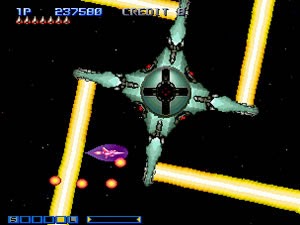

The second level begins with the opening of a wormhole.

But what’s really cool about Gradius V is the time loop. The seventh stage is the usual final base level. The sixth stage rotates back and forth as you fly forward, with drains spilling green gas all over the landscape. The fifth level takes place in an asteroid field – usually a cliche in shooters, but the screen is littered with rocks flying all over, without even a hint of slowdown.

The first level is a space station in orbit around Earth, and the second stage ends with a boss rush – relatively early for a Gradius game. There’s a biological level, much like in the previous games, but that’s about it. And, for the most part, the “themed” stages are gone. Some of it looks absolutely fantastic, especially the army of pulsing Zelos cores floating above planet Gradius, but many of the stages lack the personality that the Gradius games are known for.Ĭompared to the previous Gradius titles, the stages are on the long side. It has a hazy feel to it, consisting mostly of metallic browns and grays. The graphic style is actually a lot like Radiant Silvergun and Ikaruga, two of Treasure’s previous shooters. Gradius IV used polygonal graphics very sparsely, but they’re put to much greater use here, with dizzying backgrounds and fantastically designed bosses. The game is still played on a 2D plane, of course, but all of the visuals are 3D, thanks in part to a graphics engine provided by G.Rev, the developer behind Border Down and Under Defeat. On the surface, it looks and feel like the earlier entries, but there are numerous changes that drastically alter the way the game is played. For that, Konami brought in veteran game developers Treasure to design Gradius V.
Gradius gaiden longplay series#
After the disappointing Gradius IV, the series needed a bit of a shake-up.


 0 kommentar(er)
0 kommentar(er)
